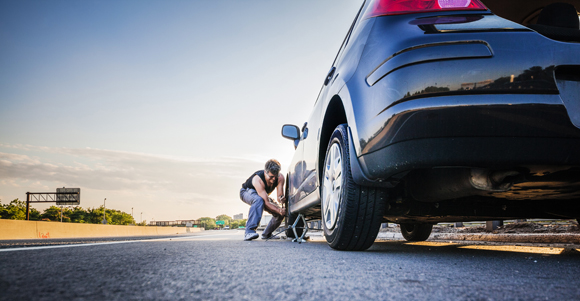How to prevent tyre blowouts in the summer heat
04/07/2016 00:00:00by Paul Fincham04/07/2016 00:00:00How to prevent tyre blowouts in the summer heatBluedrop Services


Unfortunately the warmer weather that summer hopefully brings tends to mean that motorists are driving further, faster and in more heavily loaded vehicles.
Properly inflated tyres can help to keep your drivers, fleet vehicles and the roads safe. Monitoring your fleet’s tyre pressures is important all year round. But when the tyre is under-inflated, and as a result overloaded, the heat from the summer sun can additionally increase the internal heat of the tyre from over-flexing, leading to more cases of blowouts and ultimately affecting your motor fleet insurance.
Under-inflated tyres on fully-loaded vehicles during the summer sun can experience blowouts within just a short distance if the pressure is too low. A poorly inflated tyre cannot flex enough to adapt to changes in the road surface and this is where problems occur. When a tyre operates with less than its recommended operating pressure it is more likely to fail in higher temperatures. In lower temperatures the degradation still occurs, but simply takes longer.
When to check tyre pressure
As tyre pressure is so important to vehicle safety it is essential for your fleets to be checking their tyres on a daily basis. The best time of day to do these checks is in the morning, when ambient temperatures are low. Within the heat of the day, or after driving for a while, it can take a good few hours for a tyre to go back down to its ambient temperature which is needed to measure pressure accurately. If tyres are checked when hot then the pressure should be higher than the recommended level.
There are also monitoring systems available which can regularly check the temperature and pressure of your vehicle’s tyres throughout a journey which may be worth implementing for a larger fleet.
What to do in the case of a blowout
Any one of your fleet drivers could experience a blowout and therefore they need to be trained in how to deal with it safely. Upon experiencing a tyre blowout your driver will first notice the change in handling of the vehicle and may be tempted to slam on the brakes. They should know never to do this.
A front tyre blowout will cause the vehicle to pull severely to one side, and severe braking will throw the weight to the front of the car and increase this effect. It is best to slow gradually and steer to a safe place.
A rear tyre blowout will make the vehicle weave and harsh braking can cause the vehicle to skid, you will feel the change more in the seat or body of the vehicle. All actions and braking need to be as gentle as possible whilst you get the vehicle to safety at the side of the road.
In either case your driver will need to keep a firm grip on the steering wheel, not slam on the brakes but let the car slow gradually. It is important to pull to the side of the road once they have reached a safe speed and to activate their hazard lights. Once pulled over you can exit the vehicle if safe to do so and ideally put out reflective cones or triangles which you should supply to your drivers.
It is important to train your drivers in the replacement of a tyre should they carry them, depending on the vehicle type they may actually use run-flat tyres. Drivers should also be mindful that replacement tyres are only recommended for emergency use and shouldn’t be used for long distances or at high speeds.
The benefits of regularly checked tyres
By keeping an eye on your fleet’s tyre pressures you can benefit from increased fuel efficiency, increased tyre life, reduced downtime and maintenance, increased safety of your employees, and limited affect on your business fleet insurance premiums. Tyres are a critical feature of any vehicle and the importance of their upkeep should not be overlooked.
Return to blog menuWant to find out more about Bluedrop's Fleet Insurance?
Call our friendly team now for the right insurance cover - at the best price
+441489780491
Calls recorded for training and quality.



 Privacy and Cookie Policy
Privacy and Cookie Policy